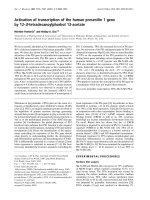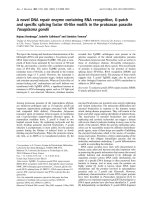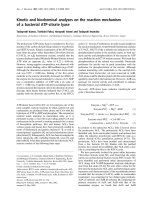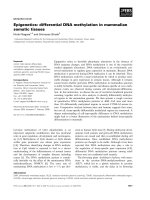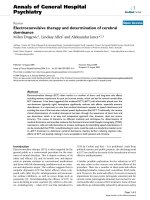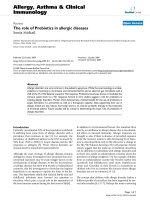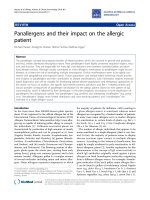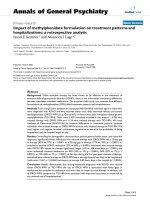Báo cáo y học: " Non-imprinted allele-specific DNA methylation on human autosomes" pptx
Bạn đang xem bản rút gọn của tài liệu. Xem và tải ngay bản đầy đủ của tài liệu tại đây (1019.57 KB, 11 trang )
Genome Biology 2009, 10:R138
Open Access
2009Zhanget al.Volume 10, Issue 12, Article R138
Research
Non-imprinted allele-specific DNA methylation on human
autosomes
Yingying Zhang
*
, Christian Rohde
*
, Richard Reinhardt
†
, Claudia Voelcker-
Rehage
‡
and Albert Jeltsch
*
Addresses:
*
School of Engineering and Science, Jacobs University Bremen, Campus Ring 1, D-28759 Bremen, Germany.
†
Max Planck Institute
for Molecular Genetics, Ihnestrasse 63-73, D-14195 Berlin-Dahlem, Germany.
‡
Jacobs Center on Lifelong Learning and Institutional
Development, Jacobs University Bremen, Campus Ring 1, D-28759 Bremen, Germany.
Correspondence: Albert Jeltsch. Email:
© 2009 Zhang et al.; licensee BioMed Central Ltd.
This is an open access article distributed under the terms of the Creative Commons Attribution License ( which
permits unrestricted use, distribution, and reproduction in any medium, provided the original work is properly cited.
Allele-specific CpG methylation<p>Single-nucleotide polymorphisms located within CpG islands are found to cause differences in CpG methylation between alleles, reflecting differences in gene expression.</p>
Abstract
Background: Differential DNA methylation between alleles is well established in imprinted genes
and the X chromosomes in females but has rarely been reported at non-imprinted loci on
autosomes.
Results: We studied DNA methylation of cytosine-guanine dinucleotide (CpG) islands on
chromosome 21 in leukocytes from several healthy individuals and observed novel cases of
pronounced differential methylation of alleles. Allele-specific methylation affected complete CpG
islands with methylation differences between alleles of up to 85%. The methylation differences
between alleles were strongly correlated with the genotypes, excluding a connection to imprinting.
We show that allele-specific methylation can lead to allelic repression of the methylated gene copy.
Based on our results, allele-specific methylation is likely to affect about 10% of all human genes and
to contribute to allele-specific expression and monoallelic gene silencing. Therefore, allele-specific
methylation represents an epigenetic pathway of how genetic polymorphisms may lead to
phenotypic variability. In most cases, we observed that some, but not all, heterozygous individuals
showed allele-specific methylation, suggesting that allele-specific methylation is the outcome of an
epigenetic drift, the direction of which is determined by the genetic differences between the alleles.
We could show that the tendency to acquire hypermethylation in one allele was inherited.
Conclusions: We observed that larger differences in methylation levels between individuals were
often coupled to allele-specific methylation and genetic polymorphisms, suggesting that the inter-
individual variability of DNA methylation is strongly influenced by genetic differences. Therefore,
genetic differences must be taken into account in future comparative DNA methylation studies.
Background
DNA methylation is a major epigenetic process that plays
essential roles in gene expression regulation, development
and disease [1-3]. In mammals, differential DNA methylation
between alleles occurs in imprinted genes [4,5] and on the
female X chromosomes [6,7]. So far, there have been few
Published: 3 December 2009
Genome Biology 2009, 10:R138 (doi:10.1186/gb-2009-10-12-r138)
Received: 17 July 2009
Revised: 23 October 2009
Accepted: 3 December 2009
The electronic version of this article is the complete one and can be
found online at /> Genome Biology 2009, Volume 10, Issue 12, Article R138 Zhang et al. R138.2
Genome Biology 2009, 10:R138
reports about allele-specific methylation (ASM) on auto-
somes not connected to the parental inheritance of the alleles
[8-10]. In imprinting and X-chromosome inactivation, ASM
leads to monoallelic expression of genes, and in some cases of
non-imprinted, autosomal ASM, a correlation between DNA
methylation and allele-specific gene expression has been doc-
umented as well [8,11].
In a previous work, we discovered ASM of three cytosine-gua-
nine dinucleotide (CpG)-rich regions in gene promoters in
leukocyte DNA derived from a healthy individual using
bisulfite conversion, subcloning and sequencing [12].
Because of the important potential contribution of ASM to
gene expression and disease [13], we initiated a larger survey
to find more examples of ASM and to understand if the ASM
of these regions relates to gene imprinting or is sequence-
dependent. Therefore, we studied the methylation pattern of
16 CpG-rich regions in gene promoters of chromosome 21 in
up to 38 individuals by bisulfite conversion, subcloning and
sequencing of individual clones. Additionally, we checked the
inter-individual DNA methylation difference at these gene
promoters with respect to a potential link to age and gender
differences.
Results
Based on our previous work on DNA methylation analysis of
gene promoters on chromosome 21 in blood derived from one
individual [12], we selected 6 low methylated (methylation
<30%), 7 intermediately methylated (methylation between
30 and 70%) and 3 highly methylated (methylation >70%)
amplicons and studied the DNA methylation status of them in
the blood derived from 10 old and 10 young individuals (5
males and 5 females in each group). The three amplicons
(176_1, 176_2 and 23_2) that previously showed ASM were
included in the analysis. Detailed information on the ampli-
cons and individuals is shown in Table 1 and Additional files
1 and 2. The amplicons are all located in CpG-rich regions sur-
rounding the transcriptional start sites of genes.
Table 1
Allele-specific methylation of amplicons among individuals and correlation with genotype
Genes and amplicons
C21orf81 HSF2BP RIPK4 CBR1
23_1 23_2 262 232 176_1 176_2
Length (bp) 370 426 400 241 302 476
CpG sites 31 26 42 25 31 44
SNP (strand) dbsnp
build 129
A/C (-) rs2297246 A/C (+)
rs56270809
A/G (-) rs2838343 A/G (+)
rs55860816
del/no del (+)
rs41563015
C/G (+) rs25678
Individuals studied 38 19 33 36 21 21
Individuals with
SNP
17820111 8
Individuals with
SNP and ASM
8719311
Coupling of ASM
and genotype
Always: C hyper-
methylated
Always: C hyper-
methylated
18 cases: G hyper-
methylated in right
part of amplicon
Always: G hyper-
methylated
Always: del hyper-
methylated
Always: C hyper-
methylated
1 case: A hyper-
methylated in left
part of amplicon
Average allelic
methylation
difference in ASM
cases
53% 60% 54% (G hyper-
methylated), 64%
(A hyper-
methylated)
39% 50% 60%
Individuals with
SNP but without
ASM
911807
Individuals without
SNP
21 11 13 25 20 13
ASM, allele-specific methylation; CpG, cytosine-guanine dinucleotide; SNP, single nucleotide polymorphism.
Genome Biology 2009, Volume 10, Issue 12, Article R138 Zhang et al. R138.3
Genome Biology 2009, 10:R138
Inter-individual variation of DNA methylation
A summary of the methylation of all amplicons in different
individuals is shown in Figure 1a. The methylation levels of
highly methylated or completely unmethylated amplicons
were usually similar among individuals, while the intermedi-
ately methylated amplicons showed higher variability (Figure
1b). Four amplicons showed a maximal inter-individual dif-
ference in their methylation levels of >50% and another five
amplicons showed variances of >30%. As an example, the
methylation pattern of amplicon 23_1 in 20 individuals is
shown in Figure 1c. When comparing the methylation differ-
ence among individuals, we did not observe any significant
methylation difference between old and young individuals or
males and females. This is consistent with former results
where no significant correlation of methylation changes with
gender or age was detected [14].
We observed that amplicons with a high methylation variance
among individuals often showed a biphasic distribution of
methylation comprising clones that were mainly unmethyl-
ated or highly methylated. This led to the question of whether
the DNA methylation varied from one cell to another or
between the two alleles in each cell. In some of these cases,
the alleles could be differentiated by the presence of a single
nucleotide polymorphism (SNP) in the sequenced region
such that the sequencing reads could be sorted according to
the allelic origin. In many of these cases we observed a clear
correlation of genotype and methylation levels, indicating the
presence of ASM (Table 1). To exclude that clonal PCR after
bisulfite conversion might have caused these results, we per-
formed individual bisulfite genomic sequencing analysis
twice for cases where ASM was observed and always obtained
similar results (Additional file 3). In addition, we used diges-
tion with methylation-sensitive restriction enzymes to con-
firm the ASM (Additional file 3). For amplicons with ASM, we
included more individuals in the analysis.
Allele-specific methylation and expression of the first
exon of the C21orf81 gene
We observed strong ASM on the first exon of the C21orf81
gene where we studied the methylation pattern of amplicon
23_2 and 23_1, which are located next to each other and
cover almost the entire CpG island (Figure 2a). The analysis
for amplicon 23_1 was performed in 38 individuals, 17 of
which had an A/C SNP in the sequenced region. Out of them,
we observed ASM with a methylation difference of >30% in
eight cases, always having the A allele hypomethylated (Table
1; Figure 2; Additional file 4). Some individuals showed a
weaker DNA methylation difference between alleles, and in
other cases no DNA methylation difference was detectable.
Within the 21 homozygous individuals, we observed a bipha-
sic distribution of DNA methylation levels in 9 cases, suggest-
ing the potential presence of ASM, although this could not be
identified because of the lack of a characteristic SNP.
The methylation pattern of amplicon 23_2 was studied in 19
individuals, including one (called 'N' in Figure 2 and the fol-
lowing) previously analyzed [12]. Altogether, eight individu-
als had an A/C SNP in this region and seven of them showed
strong ASM (Table 1; Figure 2d; Additional file 4). In all ASM
cases, the A allele was less methylated than the C allele (Fig-
ure 2e). For the 11 homozygous individuals, biphasic DNA
methylation was observed in 7 cases.
We identified the correlation between the SNPs in amplicon
23_1 and 23_2 in the genomic DNA sequence of all individu-
als with ASM. When both SNPs were present, we always
observed A-A and C-C haplotypes. In three such cases (indi-
viduals 9, 11 and 17), the A alleles in both amplicons were
hypomethylated, indicating that pronounced ASM can span a
whole CpG island (Figure 2a; Additional file 4). In individuals
3 and N, ASM was observed in one amplicon (either 23_1 or
23_2) and the other amplicon showed biphasic methylation,
but did not contain the SNP, suggesting that the whole CpG
island has ASM as well in these cases. However, there were
also cases in which the methylation states of alleles in these
two amplicons were not coupled. In individuals 4, 12 and 20,
ASM was observed in 23_2, but there was no obvious methyl-
ation difference between alleles in amplicon 23_1. No meth-
ylation difference between alleles in both amplicons was
observed in one individual (individual 1).
To determine if ASM leads to monoallelic expression of the
C21orf81 gene, we prepared RNA from leukocytes of individ-
uals 9 and 11, which showed strong ASM of both amplicons,
and converted it into cDNA. Sequencing of the cDNA revealed
that the gene was exclusively expressed from the unmethyl-
ated A allele, indicating the ASM correlates with allele-spe-
cific gene expression (Figure 2a).
We were able to check the methylation pattern of amplicon
23_1 in the parents of individual 17 (male). Like individual 17,
the mother (17_M) had an A/C SNP with the C allele methyl-
ated. The father (17_P) had an A/A genotype and showed
slight biphasic methylation but did not show clones with high
methylation characteristic for C alleles (Additional file 4).
Allele-specific methylation of a CpG island in the
HSF2BP gene
We also identified ASM on amplicon 262 containing 42 CpG
sites, which is located on a CpG island in the HSF2BP gene
(Figure 3a). The methylation state of this region was studied
in 33 individuals. In many cases, a clear boundary between
methylated CpG sites and unmethylated CpG sites was
observed in the same amplicon (Figure 3a, b). Out of 20 indi-
viduals with an A/G SNP, ASM was observed in 19 cases
(Table 1; Figure 3; Additional file 5), which showed two differ-
ent patterns of ASM (Figure 3b). In 18 individuals, the first 28
CpG sites were methylated in both alleles, whereas in the
remaining part of the amplicon, the A allele was hypomethyl-
ated. In one case (individual 2), the G allele was hypomethyl-
Genome Biology 2009, Volume 10, Issue 12, Article R138 Zhang et al. R138.4
Genome Biology 2009, 10:R138
ated throughout the entire amplicon, whereas the A allele was
methylated in the first 28 CpG sites but low methylated on the
remaining 14 CpG sites similar to what was observed for the
A allele in the other individuals. Absence of ASM was only
observed in one heterozygous individual (individual 28). In
this case, both alleles were highly methylated throughout the
whole amplicon (Figure 3b). The methylation difference
between alleles of all heterozygous individuals in amplicon
262 is summarized in Figure 3c. We analyzed the expression
state of the alleles in leukocytes from individuals 10 and 11
and the results show that both alleles were expressed (Figure
3a).
We investigated the methylation levels of amplicon 262 in
homozygous individuals and observed a strong correlation
between DNA methylation and genotype - individuals with A/
A genotype were always low methylated while individuals
with G/G were highly methylated (Figure 3d). The methyla-
tion levels of the A and G alleles from heterozygous individu-
als were similar to those of individuals with A/A or G/G
genotypes, respectively (Figure 3d), suggesting that the meth-
ylation difference is determined mainly by the polymor-
phisms between the alleles. A similar observation was made
for amplicons 23_1 and 23_2 (Additional file 6).
Inter-individual variation of DNA methylationFigure 1
Inter-individual variation of DNA methylation. (a) DNA methylation levels of all amplicons studied in blood from ten old (1 to 10) and ten young (11 to 20)
individuals. The data were sorted by the average level of DNA methylation among amplicons and individuals. Old individuals are represented by black
numbers, young individuals by red numbers. The continuous yellow to blue color code represents the DNA methylation level of the PCR products. (b)
Average DNA methylation level of all 16 amplicons among 20 individuals (1 to 20). The error bars indicate the standard deviation among the samples.
Amplicon 262 was split into 262_L (left part) and 262_R (right part) because of the different methylation observed in these two parts. Green color labeled
amplicons showed a maximal methylation difference between individuals of more than 50%; orange labels indicate amplicons with >30% methylation
difference. (c) DNA methylation pattern of amplicon 23_1 in individuals 1 to 20. Each column represents a single CpG site. Each row corresponds to one
individual.
(a)
Amplicon 23_1
Old individuals
Young individuals
Amplicons
Individuals
Amplicons
18 16 10 13 19 14 3 2 8 20 4 12 15 5 11 9 7 6 17 1
Individuals
0
20
40
60
80
100
DNA methylation [%]
(b) (c)
CpG sites
197
229
307
158
176_1
176_2
140
283
232
223
23_1
262_R
23_2
257
335
187
262_L
0 50 100
DNA methylation [%]
0 50 100
DNA methylation [%]
Genome Biology 2009, Volume 10, Issue 12, Article R138 Zhang et al. R138.5
Genome Biology 2009, 10:R138
Figure 2 (see legend on next page)
Amplicon 23_1
11
30
35
27
9
17
ASM
Individuals
15
16
19
4
18
Weak or No ASM
Individuals
20
3
12
32
1
17_M
Amplicon 23_2
4
11
12
20
ASM
N
9
1
Weak ASM
17
(a)
(c)
(d)
(b)
Allelic methylation levels in amplicon 23_1
0
20
40
60
80
100
17 9 11 17_M 30 27 35 3 1 32 12 20 19 4 18 16 15
Heterozygous individuals
DNA methylation [%]
Allele A
Allele C
Weak or no ASM
ASM
Allelic methylation levels in amplicon 23_2
0
20
40
60
80
100
17 9 N 4 111220 1
Heterozygous individuals
DNA methylation [%]
Allele A
Allele C
ASM
Weak ASM
Amplicon 23_1Amplicon 23_2
Genomic DNA
C
C
A
A
*
SNP 23_2
SNP 23_1
Allele 2
C
Allele 1
A
A
C
*
cDNA
A
*
rs56270809
rs56270809
rs2297246
methylated unmethylated unknown
(e)
GC %
0
50
100
DNA methylation [%]
0
50
100
DNA methylation [%]
Genome Biology 2009, Volume 10, Issue 12, Article R138 Zhang et al. R138.6
Genome Biology 2009, 10:R138
Allele-specific methylation of an RIPK4 intron
Amplicon 232 is located on a CpG island in an intron of the
gene RIPK4 near the transcriptional start site (Figure 4a). We
studied the DNA methylation pattern of this region in 36 indi-
viduals. Out of the 11 individuals heterozygous at an A/G SNP
in the studied region, ASM was observed in 3 cases where the
A allele was always hypomethylated. In the remaining heter-
ozygous individuals, both alleles were low methylated (Table
1; Figure 4; Additional file 7). The gene expression analysis in
leukocytes from individual 10 revealed that both alleles were
expressed (Figure 4a).
Allele-specific methylation of amplicons in the CBR1
gene
We previously identified ASM of two amplicons (176_1 and
176_2) of the CBR1 gene in blood derived from one individual
[12]. The allele with a deletion in 176_1 (dbsnp rs41563015)
and with C at a C/G SNP site in 176_2 (dbsnp rs25678) was
hypermethylated when compared with the allele without
deletion and with G at the SNP site. Here, we studied the
methylation pattern of these two regions in 20 additional
individuals (Additional file 8). For amplicon 176_1, none of
these individuals had the deletion or any other SNP in the
sequence and all showed low methylation. For amplicon
176_2, 7 out of 20 individuals were heterozygous, but both
alleles were always unmethylated. This result suggests that
the deletion was more important for ASM to occur in the
CBR1 gene promoter than the SNP in amplicon 176_2.
Discussion
Allele-specific methylation on autosomes is well established
in imprinted genes, which carry a differentially methylated
region that is methylated depending on the parental origin of
the allele [4]. The sizes of such regions vary between hun-
dreds to thousands of base pairs and the methylation differ-
ence between alleles can be up to 100%, in particular on
maternally methylated alleles. Methylation leads to the exclu-
sive expression of the maternal or paternal copy of the gene.
Recently, the allelic methylation difference of several CpG
sites next to SNPs in non-imprinted regions of the genome
was reported [8]. Here, we focused on whole CpG islands
close to the start sites of genes and identified novel regions of
ASM, which all contain a large number of CpG sites and show
strong differences in average methylation of up to 85%
between the alleles. In some cases the entire promoter of a
gene was subject to ASM. The allele-specific differences in
methylation observed here are much greater than in previ-
ously published cases.
In all cases of ASM described here, there was a full correlation
between the average allelic methylation level and allelic gen-
otype, meaning that an allele with one particular genotype
was always hypermethylated in different individuals. This
observation is not compatible with a connection between
ASM and imprinting. We conclude that the ASM identified
here is due to genetic polymorphisms between two alleles,
providing examples of genotype-epigenotype interactions.
In most cases, we observed that some but not all heterozygous
individuals showed ASM. Therefore, the ASM could be an
outcome of an epigenetic drift, the direction of which is deter-
mined by the genetic differences between the alleles ('facili-
tated epigenetic variation' [13]). For one individual with ASM,
we were also able to study the methylation and genotypes of
the parents. In this case, the tendency to acquire hypermeth-
ylation at one allele was inherited from the mother to the son.
Our data show that genetic polymorphisms strongly influence
epigenetic differences among individuals, which can affect
the interpretation of inter-individual variability of DNA
methylation level and its potential connection to human
health. For example, an initial comparison of the results
obtained with amplicon 262 suggested a very significant dif-
ference between old and young individuals in the methylation
levels of the right part of this amplicon (with a P-value of
0.0026 in two-sided t-test using the entire dataset; Figure
5a). However, amplicon 262 is subject to ASM and the distri-
bution of genotypes was unequal between both groups (Fig-
ure 5b). When DNA methylation levels were compared
among identical genotypes, there was no difference in the
Allele-specific methylation and expression of amplicons 23_1 and 23_2Figure 2 (see previous page)
Allele-specific methylation and expression of amplicons 23_1 and 23_2. (a) Example of ASM of amplicons 23_1 and 23_2 in the first exon of gene
C21orf81. The figure shows the position of these two amplicons in the UCSC genome browser and the methylation pattern of alleles in both amplicons.
Each row corresponds to one clone of bisulfite PCR products. Each column corresponds to one CpG site in the studied region. The color code indicates
different methylation states of the CpG sites (blue, unmethylated; red, methylated; white, methylation state unknown). The clones in each amplicon were
sorted according to their genotype at two SNPs (dbsnp rs56270809 on 23_2 and dbsnp rs2297246 on 23_1), the positions of which are indicated by an
arrow. By sequencing of the genomic DNA we identified the haplotype of all samples with ASM to be either A/A or C/C as schematically shown in the
lower part of the figure. Expression analysis showed that the gene is exclusively expressed from the unmethylated A allele (indicated by an asterisk) in
leukocytes (data are shown from individual 11). (b) Compilation of results from all heterozygous individuals in amplicon 23_1. The individuals were sorted
according to the decreasing methylation difference between alleles. Each row corresponds to a single allele from one individual. Each square represents
the average methylation of a CpG site encoded in a continuous yellow to blue color code. The original methylation patterns of all samples with ASM are
shown in Additional file 4. (c) Methylation level of each allele from all heterozygous individuals in amplicon 23_1. (d) Compilation of results from all
heterozygous individuals in amplicon 23_2. The original methylation patterns of all samples with ASM are shown in Additional file 4. (e) Methylation level
of each allele from all heterozygous individuals in amplicon 23_2.
Genome Biology 2009, Volume 10, Issue 12, Article R138 Zhang et al. R138.7
Genome Biology 2009, 10:R138
ASM of amplicon 262Figure 3
ASM of amplicon 262. (a) Example of ASM of amplicon 262. The figure shows the position of the amplicon in the UCSC genome browser, the positions of
the SNP (dbsnp rs2838343) used to discriminate alleles, and the allelic methylation, basically as described in the legend to Figure 2a. The line indicates the
border between the methylated and unmethylated part of the amplicon. Sequencing of cDNA showed that the gene is biallelically expressed (data are
shown from individual 10). (b) Compilation of results from all heterozygous individuals. Two patterns of ASM were observed in amplicon 262. The line
indicates the border between the methylated and unmethylated parts of the amplicon. For further details see the legend to Figure 2b. The original
methylation patterns of all samples with ASM are shown in Additional file 5. (c) Methylation level of each allele from all heterozygous individuals. For this
analysis the amplicon was split into two pieces corresponding to its left part (28 CpG sites) or right part (14 CpG sites). The data labeled with ASM_1
refer to the right part of the amplicon, ASM_2 refers to the left part and no ASM refers to the full amplicon. (d) Methylation levels of homozygous
individuals with A/A or G/G genotypes compared with the methylation levels of A or G alleles from heterozygous individuals. In this analysis the results
obtained for individual 2_L were included. The error bars indicate the standard rrror of the mean. After omission of 2_L, the methylation levels of the A
and G alleles from A/G heterozygous individuals were 28% and 79%, respectively.
(a) (b)
ASM_2
Individuals
23
30
32
1
6
7
9
20
22
24
10
13
11
4
8
15
ASM_1
2
No ASM
28
Amplicon 262
27
5
(d)
(c)
Allelic methylation levels in amplicon 262
0
20
40
60
80
100
6 30 9 23 32 8 5 15 1 27 7 20 11 4 13 10 22 24 2_L 28
Heterozygous individuals
DNA methylation [%]
Allele A
Allele G
ASM_1
ASM_2
No ASM
0
20
40
60
80
100
A/A A from A/G G from A/G G/G
Genotype
DNA methylation [%]
Allelic methylation levels in amplicon 262
Allele and Genotype
cDNA
Amplicon 262
A
G
A/G
rs2838343
GC %
methylated unmethylated unknown
0
50
100
DNA methylation [%]
Genome Biology 2009, Volume 10, Issue 12, Article R138 Zhang et al. R138.8
Genome Biology 2009, 10:R138
DNA methylation of old and young individuals (Figure 5c).
We conclude that genotype-coupled changes in DNA methyl-
ation may influence comparative DNA methylation analyses
between groups of individuals. It should be considered that
(undiscovered) genetic polymorphisms outside of the region
analyzed may have such effects as well.
In the current study we investigate ASM in leukocytes. We
previously showed biphasic methylation of amplicon 232 in
HEK293 cells, but in that sample no SNP was available to dis-
criminate the alleles and confirm the presence of ASM (Addi-
tional file 9) [12]. We did not find evidence for ASM in any of
the other amplicons in HEK293 cells, HEPG2 cells or human
fibroblasts in our previous study (Additional file 9) [12].
Although the methylation status of cultured cells may not
fully reflect the methylation status of the original tissue, this
finding suggests that tissue specific factors play a role in the
generation of ASM. There are several potential mechanisms
for how genetic differences could specifically trigger the loss
or gain of DNA methylation in one allele, such as binding sites
of DNA binding proteins that may be present on one allele but
not on the other. Predictions of transcription factor binding
sites suggested for all amplicons that the different alleles
might specifically interact with some transcription factors
(Additional file 10), similar to what has been described
recently for one case of cancer-associated ASM [9].
Our data allow for a rough estimation of how prevalent ASM
is in the human epigenome. We identified 4 regions of strong
ASM selected out of 190 genes studied for DNA methylation
ASM of amplicon 232Figure 4
ASM of amplicon 232. (a) Example of ASM of amplicon 232. The figure shows the position of the amplicon in UCSC genome browser, the positions of the
SNP (dbsnp rs55860816) used to discriminate alleles, and the allelic methylation, basically as described in the legend to Figure 2a. The correlation of the
SNP in this amplicon (dbsnp rs55860816) and a SNP (rs6586238) in the first exon of the gene as identified by sequencing of genomic DNA is schematically
shown in the lower part of the figure. SNP (rs6586238) was used to discriminate alleles in gene expression analysis. Sequencing of cDNA showed that the
gene is biallelically expressed in leukocytes. (b) Compilation of results from all heterozygous individuals. For further details see the legend to Figure 2b. (c)
Methylation level of each allele from all heterozygous individuals. The original methylation patterns of all samples with ASM are shown in Additional file 7.
(a) (b)
1
10
11
ASM
No ASM
Individuals
22
24
27
28
29
34
13
14
ASM
No ASM
0
20
40
60
80
100
1 10111424272822293413
Heterozygous individuals
DNA methylation[%]
Allele A
Allele G
Allelic methylation levels in amplicon 232
A
G
Amplicon 232
(c)
cDNA
C/T
Allele 2
T
Allele 1
C
G
A
rs6586238
rs55860816
SNP 232
SNP in exon
Genomic DNA
rs6586238
GC %
methylated unmethylated unknown
0 50 100
DNA methylation [%]
Genome Biology 2009, Volume 10, Issue 12, Article R138 Zhang et al. R138.9
Genome Biology 2009, 10:R138
in our previous study [12]. If one considers that we found
SNPs allowing us to discriminate the alleles in about 20% of
all amplicons that were carefully inspected, one may estimate
ASM to occur in about 10% of all genes in leukocytes. The
finding that about 11% of all amplicons in different tissues
showed a biphasic distribution of methylation [12] leads to a
similar estimate. We conclude, therefore, that ASM likely
affects many genes in the human genome.
Recently, allele-specific gene expression has been identified
to be a widespread phenomenon in human cells [15-18]. The
ASM may correlate with allele-specific gene expression [8,11]
and we also identified one example of such correlation in our
study. Aberrant monoallelic silencing of genes contributes to
cancer and other diseases [19,20] and allele specific hyper-
methylation of genes has been associated with cancer as well
[9]. Therefore, ASM may represent an important epigenetic
pathway connecting genetic polymorphisms and phenotypic
variability [20,21]. In the future, more genome-wide bisulfite
sequencing DNA methylation analysis with DNA from differ-
ent individuals will be required to uncover the full impact of
genetic polymorphisms on DNA methylation and gene regu-
lation for development and disease processes.
Conclusions
We observed pronounced methylation difference between
alleles spanning whole CpG islands in the non-imprinting loci
of human autosomes, and proved a correlation with allelic
gene expression level in one case. We further confirmed that
the methylation differences between alleles were strongly cor-
related with genetic polymorphisms, which can further influ-
ence the inter-individual variability of DNA methylation. Our
results suggest the ASM can affect many genes in the human
genome and the genetic differences must be taken into
account in future comparative DNA methylation studies.
Materials and methods
Genomic DNA extraction
Blood DNA was collected from 37 apparently healthy individ-
uals, including 36 of caucasian origin, and 1 from Asia (Addi-
tional file 2). All individuals were informed about the study
and declared consent in written form. Genomic DNA from
blood was extracted using a QIAamp DNA Blood Mini Kit
(Qiagen, Hilton, Germany).
DNA methylation analysis
DNA methylation analysis was carried out as described [22].
Briefly, 200 to 300 ng genomic DNA was converted by
bisulfite and used as template for PCR with primer designed
in the region of interest. Information on amplicons selected
and primer sequences are listed in Additional file 1. Around
40 clones for each amplicon were picked and sequenced using
ABI BigDye Terminator chemistry (BigDye Terminator v3.1 K
(Applied Biosystems Inc, Foster City, CA, USA) and 3730 × l
ABI 96-capillary sequencer systems equipped with capillaries
of 50-cm separation length. In all ASM cases, the presence of
the SNP was confirmed by sequencing of unconverted DNA
using primers listed in Additional file 1. In cases where ASM
was observed, the bisulfite conversion, subcloning and
sequencing analysis was performed twice in independent
experiments for the same amplicon to exclude clonal PCR
amplification. The final results presented here are a combina-
tion of the results from both experiments. The separate
results are shown in Additional file 3.
We confirmed the methylation difference between alleles by
using the methylation-sensitive restriction enzymes HpaII
(for amplicons 23_1, 23_2, and 232) and BstUI (for amplicon
262) (New England Biolabs, Ipswich, MA, USA). Genomic
DNA (250 ng) was digested at the appropriate temperature
(37°C for HpaII, 60°C for BstUI) for 12 h in buffer recom-
Correlation of DNA methylation with age in amplicon 262Figure 5
Correlation of DNA methylation with age in amplicon 262. (a) Methylation
of amplicon 262 in old and young individuals analyzed without considering
genotypes. An age-related highly significant increase in methylation appears
to be detected. (b) Distribution of A and G genotypes among old and
young individuals in our study. (c) Comparison of DNA methylation in old
and young individuals with the same genotypes. This panel shows a re-
analysis of the data plotted in (a); error bar represent the standard
deviations of the data. This representation of the data clearly indicates that
there is no age-related gain of methylation in this amplicon.
0
0.2
0.4
0.6
0.8
AA AG GG
genotype
Fraction
old
young
0
20
40
60
80
100
AA AG GG
genotype
DNA methylation [%]
old
young
(a)
(c)
P=0.0026
0.0
0.2
0.4
0.6
0.8
0-20 >20-40 >40-60 >60-80 >80-100
DNA methylation [%]
Fraction
old
young
(b)
Genome Biology 2009, Volume 10, Issue 12, Article R138 Zhang et al. R138.10
Genome Biology 2009, 10:R138
mended by the supplier. Afterwards, the PCR products were
amplified from the digested genomic DNA using the following
thermal cycling parameters: 15 minutes at 95°C, 35 cycles of
45 s at 95°C, 45 s at 50°C and 1 minute at 72°C, and finally
72°C for 5 minutes. The sequences of the PCR products were
analyzed by direct sequencing or sequencing of subclones.
The PCR products amplified from undigested genomic DNA
were used as control. The primer sequences are listed in Addi-
tional file 1.
Allele-specific mRNA expression analysis
Total RNA was extracted from leukocytes (QIAamp RNA
Blood Mini Kit, Qiagen) and was reverse-transcribed. The
cDNA was used as templates for PCR by using the following
thermal cycling parameters: 15 minutes at 95°C, 35 cycles of
45 s at 95°C, 35 s at 55°C and 50 s at 72°C and finally 72°C for
5 minutes. The primers were designed to span different exons
of genes C21orf81, HSF2BP and RIPK4 and include exonic
SNPs (listed in Additional file 1). The RT-PCR product was
analyzed by direct sequencing.
Data analysis and presentation
BiQ analyzer software was used to perform quality control
and to derive DNA methylation patterns from the sequencing
results [23]. The BDPC (Bisulfite sequencing Data Presenta-
tion and Compilation) program was used to present the meth-
ylation pattern of single amplicons, single alleles and prepare
the methylation map of all amplicons studied [24]. All data
can be accessed at [25].
Abbreviations
ASM: allele-specific methylation; CpG: cytosine-guanine
dinucleotide; SNP: single nucleotide polymorphism.
Authors' contributions
YZ and CR carried out the bisulfite conversion experiments.
YZ performed all DNA methylation data analysis and gene
expression analysis. CR established the website of the ASM
database. RR sequenced all subclones and PCR products.
CVR provided the blood samples from individuals. AJ and YZ
conceived of the study, interpreted the results and wrote the
paper. All authors contributed to discussion of results, and
read and approved the final manuscript.
Additional files
The following additional data are available with the online
version of this paper: detailed information on the amplicons
analyzed and the correlated genes, genomic positions and
primers used for bisulfite genomic sequencing and gene
expression analysis (Additional file 1); detailed information
for all individuals selected for the analysis (Additional file 2);
confirmation of the bisulfite genomic sequencing results
(Additional file 3); DNA methylation patterns of amplicons
23_1 and 23_2 in different individuals (Additional file 4);
DNA methylation patterns of amplicon 262 in different indi-
viduals (Additional file 5); methylation levels of homozygous
individuals compared with the allelic methylation levels of
heterozygous individuals for amplicons 23_1, 23_2 and 262
(Additional file 6); methylation patterns of amplicon 232 in
different individuals (Additional file 7); ASM of amplicons
176_1 and 176_2 (Additional file 8); compilation of the meth-
ylation levels of regions with ASM in HEK293 cells, HEPG2
cells and human fibroblasts from [12] (Additional file 9);
allele-specific transcription factor binding sites predicted at
the ASM amplicons and mechanism of ASM (Additional file
10).
Additional data file 1Amplicons analyzed and the correlated genes, genomic positions and primers used for bisulfite genomic sequencing and gene expression analysisAmplicons analyzed and the correlated genes, genomic positions and primers used for bisulfite genomic sequencing and gene expression analysis.Click here for fileAdditional data file 2Detailed information for all individuals selected for the analysis.Detailed information for all individuals selected for the analysis.Click here for fileAdditional data file 3Confirmation of the bisulfite genomic sequencing resultsConfirmation of the bisulfite genomic sequencing results.Click here for fileAdditional data file 4DNA methylation patterns of amplicons 23_1 and 23_2 in different individualsDNA methylation patterns of amplicons 23_1 and 23_2 in different individuals.Click here for fileAdditional data file 5DNA methylation patterns of amplicon 262 in different individualsDNA methylation patterns of amplicon 262 in different individuals.Click here for fileAdditional data file 6Methylation levels of homozygous individuals compared with the allelic methylation levels of heterozygous individuals for amplicons 23_1, 23_2 and 262Methylation levels of homozygous individuals compared with the allelic methylation levels of heterozygous individuals for amplicons 23_1, 23_2 and 262.Click here for fileAdditional data file 7Methylation patterns of amplicon 232 in different individualsMethylation patterns of amplicon 232 in different individuals.Click here for fileAdditional data file 8ASM of amplicons 176_1 and 176_2ASM of amplicons 176_1 and 176_2.Click here for fileAdditional data file 9Methylation levels of regions with ASM in HEK293 cells, HEPG2 cells and human fibroblastsMethylation levels of regions with ASM in HEK293 cells, HEPG2 cells and human fibroblasts from [12].Click here for fileAdditional data file 10Allele-specific transcription factor binding sites predicted at the ASM amplicons and mechanism of ASM.Allele-specific transcription factor binding sites predicted at the ASM amplicons and mechanism of ASM.Click here for file
Acknowledgements
This work was supported by the NGF2 program of the Federal minster of
research and education BMBF and by the Robert Bosch Foundation
(12.5.1366.0005.0). We acknowledge technical assistance by Ms Sandra
Becker, and Dr Philipp Rathert for support and discussions.
References
1. Reik W: Stability and flexibility of epigenetic gene regulation
in mammalian development. Nature 2007, 447:425-432.
2. Klose RJ, Bird AP: Genomic DNA methylation: the mark and
its mediators. Trends Biochem Sci 2006, 31:89-97.
3. Goll MG, Bestor TH: Eukaryotic cytosine methyltransferases.
Annu Rev Biochem 2005, 74:481-514.
4. Reik W, Walter J: Evolution of imprinting mechanisms: the
battle of the sexes begins in the zygote. Nat Genet 2001,
27:255-256.
5. Wilkins JF: Genomic imprinting and methylation: epigenetic
canalization and conflict. Trends Genet 2005, 21:356-365.
6. Heard E: Recent advances in X-chromosome inactivation.
Curr Opin Cell Biol 2004, 16:247-255.
7. Panning B: X-chromosome inactivation: the molecular basis of
silencing. J Biol 2008, 7:30.
8. Kerkel K, Spadola A, Yuan E, Kosek J, Jiang L, Hod E, Li K, Murty VV,
Schupf N, Vilain E, Morris M, Haghighi F, Tycko B: Genomic surveys
by methylation-sensitive SNP analysis identify sequence-
dependent allele-specific DNA methylation. Nat Genet 2008,
40:904-908.
9. Boumber YA, Kondo Y, Chen X, Shen L, Guo Y, Tellez C, Estecio MR,
Ahmed S, Issa JP: An Sp1/Sp3 binding polymorphism confers
methylation protection. PLoS Genet 2008, 4:e1000162.
10. Fraenkel S, Mostoslavsky R, Novobrantseva TI, Pelanda R, Chaudhuri
J, Esposito G, Jung S, Alt FW, Rajewsky K, Cedar H, Bergman Y:
Allelic 'choice' governs somatic hypermutation in vivo at the
immunoglobulin kappa-chain locus. Nat Immunol 2007,
8:715-722.
11. Chan HW, Kurago ZB, Stewart CA, Wilson MJ, Martin MP, Mace BE,
Carrington M, Trowsdale J, Lutz CT: DNA methylation maintains
allele-specific KIR gene expression in human natural killer
cells. J Exp Med 2003, 197:245-255.
12. Zhang Y, Rohde C, Tierling S, Jurkowski TP, Bock C, Santacruz D,
Ragozin S, Reinhardt R, Groth M, Walter J, Jeltsch A: DNA methyl-
ation analysis of chromosome 21 gene promoters at single
base pair and single allele resolution. PLOS Genet 2009,
5:e1000438.
13. Richards EJ: Inherited epigenetic variation revisiting soft
inheritance. Nat Rev Genet 2006, 7:395-401.
14. Eckhardt F, Lewin J, Cortese R, Rakyan VK, Attwood J, Burger M, Bur-
ton J, Cox TV, Davies R, Down TA, Haefliger C, Horton R, Howe K,
Jackson DK, Kunde J, Koenig C, Liddle J, Niblett D, Otto T, Pettett R,
Seemann S, Thompson C, West T, Rogers J, Olek A, Berlin K, Beck S:
DNA methylation profiling of human chromosomes 6, 20
and 22. Nat Genet 2006, 38:1378-1385.
15. Gimelbrant A, Hutchinson JN, Thompson BR, Chess A: Widespread
monoallelic expression on human autosomes. Science 2007,
Genome Biology 2009, Volume 10, Issue 12, Article R138 Zhang et al. R138.11
Genome Biology 2009, 10:R138
318:1136-1140.
16. Serre D, Gurd S, Ge B, Sladek R, Sinnett D, Harmsen E, Bibikova M,
Chudin E, Barker DL, Dickinson T, Fan JB, Hudson TJ: Differential
allelic expression in the human genome: a robust approach
to identify genetic and epigenetic cis-acting mechanisms reg-
ulating gene expression. PLoS Genet 2008, 4:e1000006.
17. Milani L, Lundmark A, Nordlund J, Kiialainen A, Flaegstad T, Jon-
mundsson G, Kanerva J, Schmiegelow K, Gunderson KL, Lonnerholm
G, Syvanen AC: Allele-specific gene expression patterns in pri-
mary leukemic cells reveal regulation of gene expression by
CpG site methylation. Genome Res 2009, 19:1-11.
18. Palacios R, Gazave E, Goni J, Piedrafita G, Fernando O, Navarro A,
Villoslada P: Allele-specific gene expression is widespread
across the genome and biological processes. PLoS ONE 2009,
4:e4150.
19. Feinberg AP, Tycko B: The history of cancer epigenetics. Nat Rev
Cancer 2004, 4:143-153.
20. Feinberg AP: An epigenetic approach to cancer etiology. Can-
cer J 2007, 13:70-74.
21. Ohlsson R, Tycko B, Sapienza C: Monoallelic expression: 'there
can only be one'. Trends Genet 1998, 14:435-438.
22. Zhang Y, Rohde C, Tierling S, Stamerjohanns H, Reinhardt R, Walter
J, Jeltsch A: DNA methylation analysis by bisulfite conversion,
cloning, and sequencing of individual clones. Methods Mol Biol
2009, 507:177-187.
23. Bock C, Reither S, Mikeska T, Paulsen M, Walter J, Lengauer T: BiQ
Analyzer: visualization and quality control for DNA methyl-
ation data from bisulfite sequencing. Bioinformatics 2005,
21:4067-4068.
24. Rohde C, Zhang Y, Jurkowski TP, Stamerjohanns H, Reinhardt R, Jelt-
sch A: Bisulfite sequencing Data Presentation and Compila-
tion (BDPC) web server - a useful tool for DNA methylation
analysis.
Nucleic Acids Res 2008, 36:e34.
25. Database for Non-imprinted Allele-specific DNA Methyla-
tion on Human Autosomes. [obs-univer
sity.de/ASM/]
26. Heinemeyer T, Wingender E, Reuter I, Hermjakob H, Kel AE, Kel OV,
Ignatieva EV, Ananko EA, Podkolodnaya OA, Kolpakov FA, Pod-
kolodny NL, Kolchanov NA: Databases on transcriptional regu-
lation: TRANSFAC, TRRD and COMPEL. Nucleic Acids Res
1998, 26:362-367.

